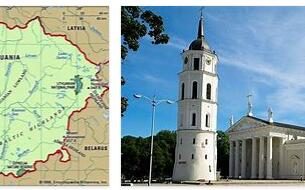Serbia is a state in the Balkans. From 1963 to 1992 Serbia was one of the 6 constituent republics of the Socialist Federal Republic of Yugoslavia. Since 1992, only Serbia and Montenegro together formed the Federal Republic of Yugoslavia, the other states had become independent. In May 2006, after a referendum, Montenegro finally split from Serbia. The present area of Serbia covers approximately the area of Bavaria and Baden-Württemberg. Kosovo, originally part of Serbia, has been under the administration of the United Nations since the war in Yugoslavia and has strived for independence, which it achieved in spring 2008 after a referendum – despite strong protests from Serbia.
Negotiations on Serbia’s accession to the EU were suspended because the Serbian government did not extradite ex-General Mladic, who is held responsible for the mass murder of around 8,000 Muslims in Srebrenica during the Yugoslav war. A certain curiosity was the fact that after Montenegro gained independence from Serbia, a joint team from Serbia-Montenegro took part in the 2006 World Cup.
The arrest of the person primarily responsible for the murder of approx. 8,000 people in Srebrenica – Radovan Karadžić (born 1945) meant great satisfaction in July 2008. This extreme Serbian nationalist – a psychiatrist by profession – is considered to be one of the worst war criminals on European soil after World War II.
| Name of the country | Republic of Serbia/Republika Srbija/Република Србија |
| Form of government | republic |
| Head of state | President, Boris Tadić (since July 11, 2004, re-elected on February 3, 2008) |
| Geographical location | Southeast Europe and the Balkans |
| National anthem | Bože Pravde |
| Population | about 7.3 million (Credit: Countryaah: Serbia Population) |
| Ethnicities | Serbs, Bosniaks, Hungarians and Roma and Sinti, Macedonians, Croats |
| Religions | mainly Serbian Orthodoxas well as Roman Catholic, Protestant and Muslim believers |
| Languages | Serbian and minority languages such as Albanian |
| Capital | Belgrade |
| Surface | 77,484 km² |
| Highest mountain | Đeravica in the Prokletije Mountains in southwest Serbia (Kosovo) with an altitude of 2,656 m |
| Longest river | Danube with a length within Serbia of around 588 km |
| Largest lake | Djerdapsee with an area of around 163 km² |
| International license plate | SRB |
| National currency | dinar |
| Time difference to CET | 0 h |
| International phone code | + 381 |
| Mains voltage, frequency | 220 volts, 50 hertz |
| Internet Top Level Domain (TLD) | .rs (until 09/30/2009.yu) |
Serbia: history
Before the year 1000
The Illyrians and Celts inhabited today’s Serbian territory long before our era. In 300 BC, the Romans conquered the area. In 395 AD the Roman Empire was divided and today’s Serbia became Byzantine. In the 6th and 7th centuries the Slavic tribes immigrated to the Balkans. Serbia became Christian through the Byzantine influence.
From the year 1000 to the 17th century
According to Abbreviationfinder website, in 1217, Stephen was crowned by the Pope and the first Serbian kingdom was founded. Serbia experienced a considerable boom.
In 1330 Serbia triumphed over the Bulgarians and thereby became the strongest power in the region.
On June 28, 1389, the battle took place on the Amselfeld, in which Serbia lost to the Ottomans. This battle has left the Serbs with traumatic memories to this day. Since the blackbird field is in Kosovo, Serbia finds it particularly difficult to recognize the independence of this part of the country. From this point on the Turkish rule began, which lasted until 1878. The battle on the blackbird field, which is located in what is now Kosovo near Pristina, is currently being religiously transfigured in Serbia.
In the 15th century, however, Serbia was divided between the Ottomans and Austria-Hungarians.
In the 18th and 19th centuries
In 1804 and 1815 there were two revolts against Turkish rule. After the second uprising under Prince Miloš Obrenovic (1783-1860), Serbia received its autonomy in 1817, although it remained tributary to the Ottomans. It got its own constitution and parliament. Miloš Obrenovic was the founder of the Obrenovic dynasty.
In 1878 the Berlin Congresses took place, in which Serbia and Montenegro finally became independent and formed two kingdoms.
In 1903, with Aleksandar Obrenovic (1876 to 1903), King of Serbia from 1889 to 1903, the Obrenovic dynasty ended. Aleksandar Obrenovic was murdered together with his wife Draga in the course of a conspiracy surrounding Dragutin Dimitrijevic (1877-1917) in June 1903. Dimitrijevic was also involved in the assassination attempt against the Austro-Hungarian heir to the throne Franz Ferdinand on June 28, 1914 in Sarajevo. He was executed in 1917.
In the 20th century
On June 28, 1914, the assassination attempt on the Austrian heir to the throne Ferdinand took place in Sarajevo. As a result, Austria-Hungary annexed Serbia, which triggered the First World War.
On December 1, 1918, after the end of the war, Serbia, Croatia and Slovenia formed the “Kingdom of Serbs, Croats and Slovenes.”
In 1929 this kingdom was renamed “Kingdom of Yugoslavia”.
In 1941, Yugoslavia joined fascist Germany and Italy. This triggered a coup d’état, which caused Germany to invade Yugoslavia and divide it up between Italy, Bulgaria and Hungary. Only Croatia remained independent under the right-wing Ustaše movement. With the annexation the resistance of the communist people’s liberation movement against the German occupiers began.
In 1944 partisans under Josip Broz Tito (1892-1980) and the Communist Party liberated the country with the help of Russian troops. The former kingdom was divided into republics.
In 1946 the constitution of the new “Federal People’s Republic of Yugoslavia” came into force under Tito. In it the country was divided into six republics (Bosnia-Herzegovina, Croatia, Macedonia, Montenegro, Serbia and Slovenia). Within Serbia, the two autonomous provinces Kosovo and Vojvodina also belonged to it. From 1945 to 1946 the country was first called Democratic Federal Yugoslavia, and from 1946 Federal People’s Republic of Yugoslavia. In 1963 the country was renamed again, namely the Socialist Federal Republic of Yugoslavia.
In 1947 the national territory was re-established within its 1941 borders and expanded to include some Italian areas.
In 1948 Tito broke away from the Soviet Union and Yugoslavia fell out of the Eastern Bloc.
From 1950 Yugoslavia built a self-governing socialism independent of the Eastern Bloc.
In 1953 Tito became President and campaigned for a unified Yugoslavia.
In 1966-73, subliminal nationalist conflicts began in Kosovo and Croatia.
In 1974 a new constitution was introduced that gave the republics more rights.
In 1980 Tito died. With his death, nationalist conflicts arose again, especially on the part of the Albanians, who were demanding their own republic.
In 1986 Slobodan Miloševic (1941 – 2006) became party leader of the Communist Party of Serbia. His politics were strongly influenced by Serbian nationalism.
In 1989 the autonomy status of Kosovo and Vojvodina was revoked, which fueled the ever-present conflict in Kosovo. In addition, Miloševic became President of Serbia in the Socialist Federal Republic of Yugoslavia, which existed from 1963 to 1991.
In 1991 Croatia and Slovenia declared their independence. From September the war began in Croatia.
In 1992 Bosnia-Herzegovina also declared independence. The war continued in Bosnia after Serbian troops attacked. It turned into an ethnic war that led to “acts of purge”. On April 6th, the USA and EU member states recognized the independence of Bosnia-Herzegovina. As a result, on April 27, the Federal Republic of Yugoslavia was re-constituted, which now consisted of Serbia and Montenegro.
In 1992 the republics of Serbia and Montenegro formed the Federal Republic of Yugoslavia.
From 05/30/1992 the UN imposed sanctions against Yugoslavia.
In 1995 the Muslim enclaves were taken, which were actually protected areas of the UN. There were mass shootings and the Srebenica massacre in July with probably 8,000 Muslim youths and men murdered. The UN force was under the command of Dutch soldiers who were completely helpless in the face of the war criminals and who did not manage to prevent the atrocities. On the contrary, the picture of the Dutch commander, who was drinking champagne with the responsible Bosnian-Serbian general, Ratko Mladic (born 1942), while the Muslims were already being transported away, went around the world.
In August 1994, NATO intervened with air strikes.
On December 14th, 1995 the Dayton Agreement was signed and with it the Declaration of Peace. However, KFOR soldiers remained stationed in Bosnia-Herzegovina.
In 1996 the great flight of the Serbs from the Bosnian Sarajevo to Serbia began. The UN sanctions against Serbia were lifted again.
In 1997 Miloševic’s term as President of Serbia ended and he became President of the Federal Republic of Yugoslavia.
In 1998 the conflict broke out openly in Kosovo. Its independence in 1992 was never recognized by the Serbs. Serbian soldiers started an offensive. There were again massacres and ethnic cleansing, hundreds of thousands of Albanians fled to Albania or Macedonia.
After several planned meetings failed, the UN launched air raids on Serbia on March 24, 1999.
Two and a half months later, Yugoslavia gave way on June 10, 1999, whereupon the air strikes stopped.
October 5, 2000, after mass protests, Slobodan Miloševic was forced to resign. He was extradited to the War Crimes Tribunal in The Hague on June 28, 2001 on the basis of charges on May 27, 1999 by Carla del Ponte, the chief prosecutor of the International Court of Justice in The Hague, for war crimes, genocide and crimes against humanity. He died there in his cell on March 11, 2006.
On October 7th, 2000 Vojislav Kostunica (born 1944) was elected as his successor as president.
On December 25th, 2000 the charismatic Zoran Djindjic (1952 – 2003), who spoke fluent German among other things, became Serbian Prime Minister.
April 22nd, 2001 new elections took place in Montenegro. Filip Vujanovic (born 1954) remained Prime Minister.
In 2002 Serbia and Montenegro got a new constitution through mediation by the EU.
On February 4th, 2003, the Federal Republic of Yugoslavia was renamed Serbia and Montenegro.
On March 12, 2003, the great hope for a democratic development of the country suffered a severe blow after the murder of Zoran Djindjic. Djindjic had not only fought with the old cadres, but above all made organized crime, to which numerous former and still active cadres belonged and still belong, to the enemy.
Svetozar Marovic (born 1955) has been the first head of state and government of Serbia and Montenegro since 2003. His election took place on March 7, 2003. In
2004, after early elections, Boris Tadic (born 1958) became the new Serbian president. The head of government of Serbia has been Vojislav Kostunica (born 1944) since June 2004. From October 7, 2000 to March 7, he was the President of Serbia.
2005 was the last constitutional amendment of Serbia and Montenegro.
On May 21, 2006, a referendum on independence was held in Montenegro, which was ratified with 55% approval. On June 3, the parliament of Montenegro proclaimed independence from Serbia. With this the state union of Serbia-Montenegro ceased to exist. And Kosovo also broke away from Serbia and proclaimed its independence on February 17, 2008.
In the presidential election on January 20, 2008, the ultra-nationalist Tomislav Nicolic won with 39.4% of the votes against his opponent and more western-oriented Boris Tadic, who received 35.4% of the votes. As neither of the two received an absolute majority, a runoff election on February 3rd decided the future President of Serbia. Boris Tadic
won the election with around 52% of the vote. The majority of Serbia had spoken out in favor of opening up to the EU and the West.



